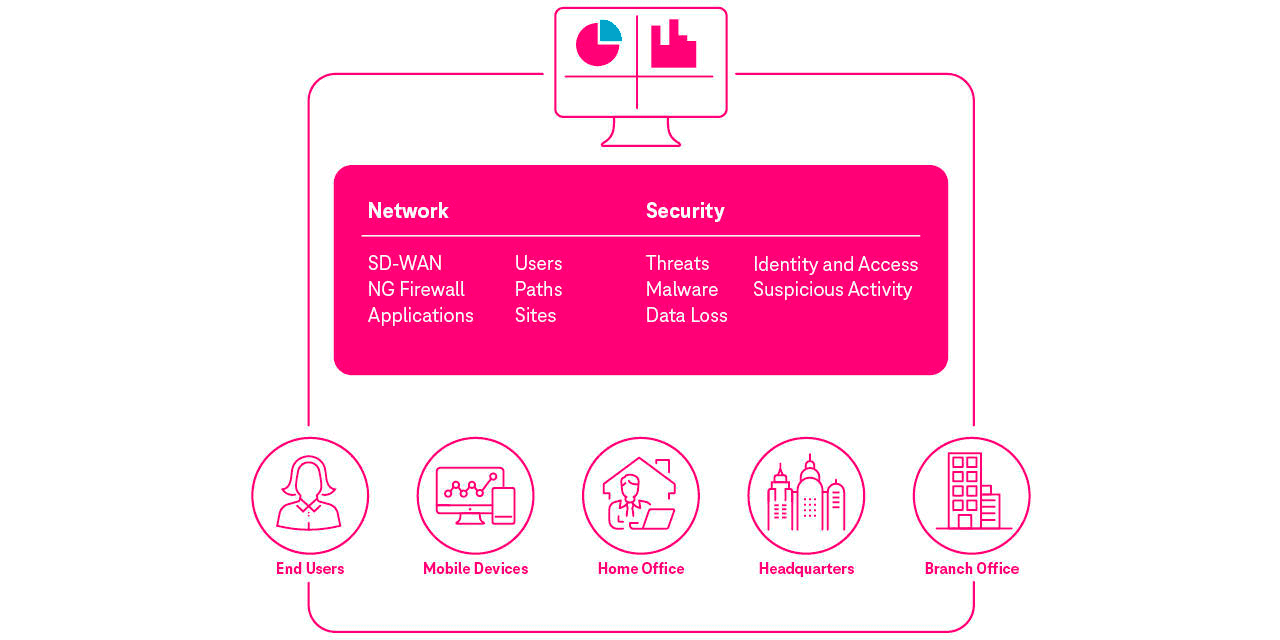O que exatamente é SASE e o que o torna como um smartphone?
06/08/2021 por Eric Biederbeck

Ainda tem um telefone fixo em casa? Você usa cheques? Possui um livro de endereços físico? Envia postais ou cartas? Usa uma câmera analógica para tirar suas fotos de férias?
Provavelmente, você respondeu “não” a pelo menos uma dessas perguntas. A razão? Os dispositivos smart mudaram fundamentalmente a maneira como vivemos e nos comunicamos digitalizando as tarefas diárias.
Quando você pode acessar tudo de um só lugar, é muito mais fácil do que carregar um talão de cheques, livro de endereços, trocos e muito mais em seus bolsos. Os smartphones consolidaram muitas das coisas que costumavam ser separadas, reunindo-as em um único local. Agora você pode reviver um feriado passado, enviar um e-mail com novidades para um amigo e verificar seu saldo bancário em apenas alguns toques.
Assim como os smartphones consolidaram objetos físicos, o SASE oferece a mesma funcionalidade para redes de longa distância definidas por software (SD-WAN). Muitas vezes um chavão muito citado, SASE é um termo usado para descrever uma arquitetura de rede que combina rede e segurança SD-WAN em um serviço de nuvem para simplificar a implantação de WAN, da mesma forma que seu smartphone consolida vários aplicativos para fornecer tudo o que você precisa de apenas uma fonte.
De onde vem o termo SASE?
SASE significa Secure Access Service Edge. Embora tenha recebido esse nome apenas pelo Gartner em 2019, vários especialistas em SD-WAN, incluindo a Deutsche Telekom, seguem uma estrutura SASE para SD-WAN há vários anos. É um método que essencialmente cria um único painel de vidro através do qual você pode visualizar sua rede e segurança no mesmo local.

O SASE reúne os recursos de rede da SD-WAN com soluções de segurança aprimoradas em uma única solução holística. O serviço de rede de SASE se concentra em soluções normalmente fornecidas pela maioria dos fornecedores de SD-WAN, enquanto o elemento de segurança depende de agentes de segurança de acesso à nuvem, acesso à rede de confiança zero, firewalls como serviço e isolamento de navegador remoto. Embora seja possível implementar SD-WAN sem uma arquitetura de SASE, a introdução de elementos de segurança aprimorados isoladamente pode levar a custos crescentes, um cenário complexo de fornecedores e a necessidade de mais hardware. Com o SASE, todos os usuários finais desfrutam da mesma experiência de acesso, independentemente de quais recursos eles precisam e de onde estão trabalhando, com SASE simplificando o processo de autenticação.
Como o SASE melhora a SD-WAN?
Um mito comum sobre SASE é que ele é uma solução projetada para se acoplar às tecnologias de SD-WAN existentes para aumentar a segurança, mas esse não é o caso. Em vez disso, SASE é uma metodologia de arquitetura que pode, como opção, maximizar a eficácia da SD-WAN e otimizar sua infraestrutura de rede.
A SD-WAN implantada em uma arquitetura de SASE cria uma oferta perfeita, segura e bem conectada para usuários finais, empresas e equipes técnicas responsáveis pela conectividade e manutenção da rede.
É semelhante ao aplicativo de e-mail em seu smartphone, que provavelmente está conectado a um dispositivo de segurança móvel, com os dois aplicativos trabalhando juntos em harmonia.
Benefícios do SASE
Poderíamos escrever um artigo de blog inteiro apenas focando nos benefícios do SASE, mas alguns dos vencedores claros são:
- Reduz custos e complexidade devido à oferta de serviço único.
- Reduz a quantidade de hardware necessária no local.
- Os usuários finais têm a mesma experiência de alta qualidade, independentemente de onde acessam e de quais recursos precisam acessar.
- As políticas de segurança são aplicadas com Acesso de - --- Rede Zero Trust e protegem contra ameaças externas e internas.
- Reduz o tempo de administração em torno da implantação, monitoramento e manutenção de sistemas para a equipe técnica.
- As políticas podem ser definidas centralmente por equipes e implementadas por meio de sistemas em nuvem para serem aplicadas no ponto correto para os usuários.
O que SASE significa para sua estratégia de rede?
Garantir que seus provedores de rede e segurança estejam trabalhando para fornecer os resultados de que você precisa é fundamental para o sucesso dos negócios. Com o trabalho remoto mais requisitado do que nunca, ter níveis adicionais de segurança, mantendo a largura de banda e a capacidade de resposta da rede, é essencial, não apenas algo “bom de se ter”.
Da mesma forma que os smartphones estão se tornando cada vez mais parte integrante da vida cotidiana, acompanhar as tendências da tecnologia não é diferente quando se trata de serviços de rede.
A SD-WAN em uma arquitetura de SASE permite que você dê suporte a um grande número de funcionários que trabalham remotamente ou em vários locais. Isso significa que você pode se proteger melhor contra ameaças e problemas de segurança tradicionalmente associados a VPNs e firewalls remotos. O SASE também é muito flexível graças aos seus controles centrais. Você pode aumentar ou diminuir o serviço conforme necessário e ajustar as configurações de segurança para corresponder.
Os funcionários podem acessar recursos de forma eficaz de qualquer local com acesso atribuído a perfis de funcionários centralmente. Não há necessidade de esperar por permissões e verificações. Além disso, o SASE permite acesso seguro e autorizado enquanto protege com a autenticação Zero Trust.
SASE é a arquitetura ou estrutura de base para se construir sua solução em SD-WAN, reunindo seus novos recursos de rede com maior segurança em uma única solução holística. Na era do ‘Novo Trabalho’, onde a conectividade deve ser segura e sob demanda, o SASE fornece um único painel de vidro para todos os seus requisitos de comunicação.
Para entender mais sobre SASE e SD-WAN, entre em contato com nossa equipe de especialistas hoje mesmo.
Você quer mais insights de profissionais de rede e conectividade inteligente?
